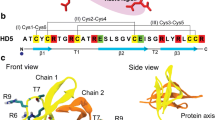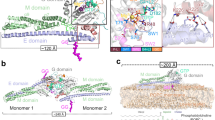Abstract
During the final step of the bacteriophage infection cycle, the cytoplasmic membrane of host cells is disrupted by small membrane proteins called holins. The function of holins in cell lysis is carried out by forming a highly ordered structure called lethal lesion, in which the accumulation of holins in the cytoplasmic membrane leads to the sudden opening of a hole in the middle of this oligomer. Previous studies showed that dimerization of holins is a necessary step to induce their higher order assembly. However, the molecular mechanism underlying the holin-mediated lesion formation is not well understood. In order to elucidate the functions of holin, we first computationally constructed a structural model for our testing system: the holin S105 from bacteriophage lambda. All atom molecular dynamic simulations were further applied to refine its structure and study its dynamics as well as interaction in lipid bilayer. Additional simulations on association between two holins provide supportive evidence to the argument that the C-terminal region of holin plays a critical role in regulating the dimerization. In detail, we found that the adhesion of specific nonpolar residues in transmembrane domain 3 (TMD3) in a polar environment serves as the driven force of dimerization. Our study therefore brings insights to the design of binding interfaces between holins, which can be potentially used to modulate the dynamics of lesion formation.
Graphic Abstract








Similar content being viewed by others
References
Abraham MJ, Murtola T, Schulz R, Páll S, Smith JC, Hess B, Lindahl E (2015) GROMACS: high performance molecular simulations through multi-level parallelism from laptops to supercomputers. SoftwareX 1:19
Ahammad T, Drew DL Jr, Sahu ID, Khan RH, Butcher BJ, Serafin RA, Galende AP, McCarrick RM, Lorigan GA (2020) Conformational differences are observed for the active and inactive forms of pinholin s21 using DEER spectroscopy. J Phys Chem B 124(50):11396–11405
Almeida JG, Preto AJ, Koukos PI, Bonvin AM, Moreira IS (2017) Membrane proteins structures: a review on computational modeling tools. Biochim Biophys Acta Biomembr 1859:2021
Anderson W, Ohlendorf D, Takeda Y, Matthews B (1981) Structure of the cro repressor from bacteriophage \(\lambda \) and its interaction with DNA. Nature 290:754
Aravind L, Anantharaman V, Balaji S, Babu MM, Iyer LM (2005) The many faces of the helix-turn-helix domain: transcription regulation and beyond. FEMS Microbiol Rev 29:231
Buchan DW, Jones DT (2019) The PSIPRED protein analysis workbench: 20 years on. Nucleic Acids Res 47:W402
Choma C, Gratkowski H, Lear JD, DeGrado WF (2000) Asparagine-mediated selfassociation of a model transmembrane helix. Nat Struct Biol 7:161
Deber CM, Ng DP (2015) Helix–helix interactions: is the medium the message? Structure 23:437
Drin G, Antonny B (2010) Amphipathic helices and membrane curvature. FEBS Lett 584:1840
Fiser A (2010) Template-based protein structure modeling. Methods Mol Biol 673:73–94
Giménez-Andrés M, Čopič A, Antonny B (2018) The many faces of amphipathic helices. Biomolecules 8:45
Gorski A, Miedzybrodzki R (2020) Phage therapy: current status and perspectives. Med Res Rev 40:459
Gründling A, Bläsi U, Young R (2000) Biochemical and genetic evidence for three transmembrane domains in the class i holin, \(\lambda \) s. J Biol Chem 275:769
Gründling A, Manson MD, Young R (2001) Holins kill without warning. Proc Natl Acad Sci USA 98:9348
Huang J, Rauscher S, Nawrocki G, Ran T, Feig M, de Groot BL, Grubmüller H, MacKerell AD (2017) CHARMM36m: an improved force field for folded and intrinsically disordered proteins. Nat Methods 14:71
Hub JS, De Groot BL, Van Der Spoel D (2010) G WHAM a free weighted histogram analysis implementation including robust error and autocorrelation estimates. J Chem Theory Comput 6:3713
Jacob JT, Klein E, Laxminarayan R, Beldavs Z, Lynfield R, Kallen AJ, Ricks P, Edwards J, Srinivasan A, Fridkin S et al (2013) Vital signs: carbapenem-resistant enterobacteriaceae. Morbid Mortal Wkly Rep 62:165
Jo S, Kim T, Iyer VG, Im W (2008) CHARMM-GUI: a web-based graphical user interface for CHARMM. J Comput Chem 29:1859
Joh NH, Min A, Faham S, Whitelegge JP, Yang D, Woods VL, Bowie JU (2008) Modest stabilization by most hydrogen-bonded side-chain interactions in membrane proteins. Nature 453:1266
Johnson RM, Hecht K, Deber CM (2007) Aromatic and cation-\(\pi \) interactions enhance helix–helix association in a membrane environment. Biochemistry 46:9208
Johnston JM, Filizola M (2011) Showcasing modern molecular dynamics simulations of membrane proteins through G protein-coupled receptors. Curr Opin Struct Biol 21:552
Jones DT (1999) Protein secondary structure prediction based on position-specific scoring matrices. J Mol Biol 292:195
Jorgensen WL, Chandrasekhar J, Madura JD, Impey RW, Klein ML (1983) Comparison of simple potential functions for simulating liquid water. J Chem Phys 79:926
Krogh A, Larsson B, Von Heijne G, Sonnhammer EL (2001) Predicting transmembrane protein topology with a hidden Markov model: application to complete genomes. J Mol Biol 305:567
Langosch D, Arkin IT (2009) Interaction and conformational dynamics of membrane-spanning protein helices. Protein Sci 18:1343
Laxminarayan R, Duse A, Wattal C, Zaidi AK, Wertheim HF, Sumpradit N, Vlieghe E, Hara GL, Gould IM, Goossens H et al (2013) Antibiotic resistance—the need for global solutions. Lancet infect Dis 13:1057
Lin DM, Koskella B, Lin HC (2017) Phage therapy: An alternative to antibiotics in the age of multi-drug resistance. World J Gastrointest Pharmacol Ther 8:162
MacGowan A, Macnaughton E (2017) Antibiotic resistance. Medicine 45:622
Maroun RG, Krebs D, El Antri S, Deroussent A, Lescot E, Troalen F, Porumb H, Goldberg ME, Fermandjian S (1999) Self-association and domains of interactions of an amphipathic helix peptide inhibitor of HIV-1 integrase assessed by analytical ultracentrifugation and NMR experiments in trifluoroethanol/H\(_2\)O mixtures. J Biol Chem 274:34174
Matthews B, Ohlendorf D, Anderson W, Takeda Y (1982) Structure of the DNA-binding region of lac repressor inferred from its homology with cro repressor. Proc Natl Acad Sci USA 79:1428
Mravic M, Thomaston JL, Tucker M, Solomon PE, Liu L, DeGrado WF (2019) Packing of apolar side chains enables accurate design of highly stable membrane proteins. Science 363:1418
Pabo CO, Lewis M (1982) The operator-binding domain of \(\lambda \) repressor: structure and DNA recognition. Nature 298:443
Páll S, Abraham MJ, Kutzner C, Hess B, Lindahl E (2014) Tackling exascale software challenges in molecular dynamics simulations with GROMACS. In: International conference on exascale applications and software. Springer, pp 3–27
Pires DP, Cleto S, Sillankorva S, Azeredo J, Lu TK (2016) Genetically engineered phages: a review of advances over the last decade. Microbiol Mol Biol Rev 80:523
Rees D, DeAntonio L, Eisenberg D (1989) Hydrophobic organization of membrane proteins. Science 245:510
Reißer S, Strandberg E, Steinbrecher T, Elstner M, Ulrich AS (2018) Best of two worlds? how md simulations of amphiphilic helical peptides in membranes can complement data from oriented solid-state NMR. J Chem Theory 14:6002
Romero-Calle D, Guimarães Benevides R, Góes-Neto A, Billington C (2019) Bacteriophages as alternatives to antibiotics in clinical care. Antibiotics 8:138
Rosinski JA, Atchley WR (1999) Molecular evolution of helix-turn-helix proteins. J Mol Evol 49:301
Salmond GP, Fineran PC (2015) A century of the phage: past, present and future. Nat Rev Microbiol 13:777
Souza PCT, Alessandri R, Barnoud J, Thallmair S, Faustino I, Grünewald F, Patmanidis I, Abdizadeh H, Bruininks BMH, Wassenaar TA, Kroon PC, Melcr J, Nieto V, Corradi V, Khan HM, Domański J, Javanainen M, Martinez-Seara H, Reuter N, Best RB, Vattulainen I, Monticelli L, Periole X, Tieleman DP, de Vries AH, Marrink SJ (2021) Martini 3: a general purpose force field for coarse-grained molecular dynamics. Nat Methods 18(4):382–388. https://doi.org/10.1038/s41592-021-01098-3
Stevens TJ, Arkin IT (1999) Are membrane proteins “inside-out” proteins? Proteins Struct Funct Bioinform 36:135
Su J, Thomas AS, Grabietz T, Landgraf C, Volkmer R, Marrink SJ, Williams C, Melo MN (2018) The n-terminal amphipathic helix of pex11p self-interacts to induce membrane remodelling during peroxisome fission. Biochim Biophys Acta Biomembr 1860:1292
Su, Z, Wu, Y (2020) Multiscale simulation unravel the kinetic mechanisms of in ammasome assembly. Biochim Biophys Acta Mol Cell Res 1867:118612
Su Z, Wu Y (2019) Computational studies of protein–protein dissociation by statistical potential and coarse-grained simulations: a case study on interactions between colicin e9 endonuclease and immunity proteins. Phys Chem Chem Phys 21:2463
Su Z, Wu Y (2020) A computational model for understanding the oligomerization mechanisms of TNF receptor superfamily. Comput Struct Biotechnol J 18:258
Su Z, Wu Y (2020) A systematic test of receptor binding kinetics for ligands in tumor necrosis factor superfamily by computational simulations. Int J Mol Sci 21:1778
Su Z, Wu Y (2020) Computational simulations of TNF receptor oligomerization on plasma membrane. Proteins Struct Funct Bioinform 88:698
Su Z, Mahmoudinobar F, Dias CL (2017) Effects of trimethylamine-n-oxide on the conformation of peptides and its implications for proteins. Phys Rev Lett 119:108102
Thompson CJ, Su Z, Vu VH, Wu Y, Leckband DE, Schwartz DK (2020) Cadherin clusters stabilized by a combination of specific and nonspecific cis-interactions. eLife 9:e59035
To KH, Young R (2014) Probing the structure of the s105 hole. J Bacteriol 196:3683
Wang I-N, Smith DL, Young R (2000) Holins: the protein clocks of bacteriophage infections. Annu Rev Microbiol 54:799
Welch JT, Kearney WR, Franklin SJ (2003) Lanthanide-binding helix-turn-helix peptides: solution structure of a designed metallonuclease. Proc Natl Acad Sci USA 100:3725
White R, Chiba S, Pang T, Dewey JS, Savva CG, Holzenburg A, Pogliano K, Young R (2011) Holin triggering in real time. Proc Natl Acad Sci USA 108:798
Xu D, Zhang Y (2012) Ab initio protein structure assembly using continuous structure fragments and optimized knowledge-based force field. Proteins Struct Funct Bioinform 80:1715
Yang J, Zhang Y (2015) I-TASSER server: new development for protein structure and function predictions. Nucleic Acids Res 43:W174
Young R (2013) Phage lysis: do we have the hole story yet? Curr Opin Microbiol 16:790
Zhang S-Q, Kulp DW, Schramm CA, Mravic M, Samish I, DeGrado WF (2015) The membrane- and soluble-protein helix–helix interactome: similar geometry via different interactions. Structure 23:527
Zhou FX, Merianos HJ, Brunger AT, Engelman DM (2001) Polar residues drive association of polyleucine transmembrane helices. Proc Natl Acad Sci USA 98:2250
Zhukovsky MA, Filograna A, Luini A, Corda D, Valente C (2019) Protein amphipathic helix insertion: a mechanism to induce membrane fission. Front Cell Dev Biol 7:291
Acknowledgements
This work is supported by the National Institutes of Health under Grant Numbers R01GM120238 and R01GM122804. This work is also partially supported by a Start-up Grant from Albert Einstein College of Medicine. Computational support is provided by Albert Einstein College of Medicine High Performance Computing Center, and the NSF through XSEDE resources under Grant Number TG-MCB200002.
Author information
Authors and Affiliations
Corresponding author
Electronic supplementary material
Below is the link to the electronic supplementary material.
Rights and permissions
About this article
Cite this article
Zhou, B., Wu, Y. & Su, Z. Computational Simulation of Holin S105 in Membrane Bilayer and Its Dimerization Through a Helix-Turn-Helix Motif. J Membrane Biol 254, 397–407 (2021). https://doi.org/10.1007/s00232-021-00187-w
Received:
Accepted:
Published:
Issue Date:
DOI: https://doi.org/10.1007/s00232-021-00187-w




